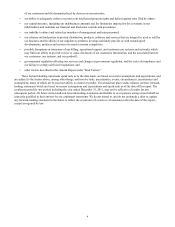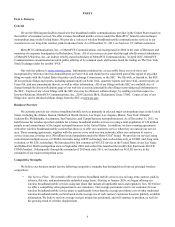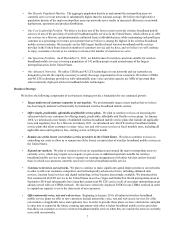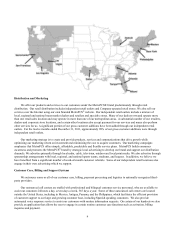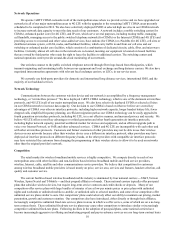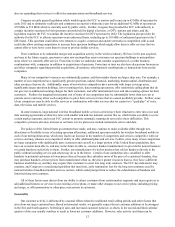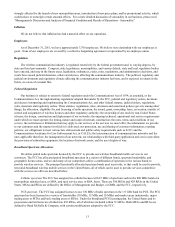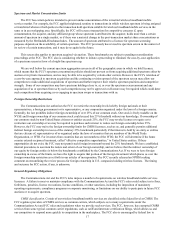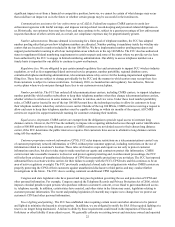Metro PCS 2011 Annual Report Download - page 23
Download and view the complete annual report
Please find page 23 of the 2011 Metro PCS annual report below. You can navigate through the pages in the report by either clicking on the pages listed below, or by using the keyword search tool below to find specific information within the annual report.12
also are expanding their services to offer telecommunications and broadband services.
Congress recently passed legislation which would require the FCC to auction and license up to 65 MHz of spectrum by
early 2015 and to ultimately reallocate and commence an auction within nine years for an additional 42 MHz of spectrum at
470 MHz to 512 MHz which is currently used by public safety. Further, Congress has provided the FCC with authority to
conduct incentive auctions for both spectrum currently held by digital television, or DTV, stations and others, and the
legislation requires the FCC to conduct the incentive auctions for DTV spectrum by 2022. The legislation also provides for
authority for the FCC to allocate spectrum on an unlicensed basis, including up to 195 MHz of unlicensed spectrum in the 5
GHz band. This spectrum could allow new entrants to acquire, construct and operate networks in competition with us and
could also allow existing competitors to increase their spectrum holdings which might allow them to offer services that we
cannot offer or have lower costs than we incur to provide similar services.
There continues to be substantial merger and acquisition activity in the wireless industry. We have in the past acquired,
and may in the future acquire, spectrum to enter new metropolitan areas or increase our spectrum holdings in metropolitan
areas where we currently offer service. From time to time we undertake and consider acquisitions of, or other business
combinations with, companies in addition to acquisitions of spectrum. From time to time we also have discussions between us
and other companies regarding potential acquisitions, divestitures, other business combinations, or transactions between the
companies.
Many of our competitors' resources are substantially greater, and their market shares are larger, than ours. For example, a
number of our competitors have significantly greater spectrum, capital, financial, marketing, human capital, distribution and
other resources than we do. Additionally, many of our wireless competitors have networks with larger coverage areas,
significantly larger spectrum holdings, lower roaming prices, data roaming agreements, offer nationwide calling plans that do
not give rise to additional roaming charges for their customers, and offer international voice and data roaming options for their
customers. Further, the marginal incremental cost of some of our competitors may be substantially lower than our cost to
provide service and may allow such competitors to price their services at rates that we cannot profitably provide. Further, some
of our competitors may be able to offer services in combination with other services that we cannot in a “quad play” of voice,
data, television, and mobile services.
In some instances, large national wireless broadband mobile services carriers have been reluctant to enter into voice and
data roaming agreements at attractive rates with smaller and mid-tier national carriers like us, which limits our ability to serve
certain market segments, and recent FCC actions to promote automatic roaming do not resolve these difficulties. This
competitive pressure also may increase as our basic service plans now include nationwide service and data.
The policies of the United States government have made, and may continue to make available either through new
allocations or flexibility in use of existing spectrum allocations, additional spectrum suitable for wireless broadband mobile in
each of our metropolitan areas, which may lead to an increase in the number of competitors and services competitive with our
services and may enhance our competitors' ability to offer additional plans and services. Further, since many of our competitors
are large companies with significantly more customers and can sell to a larger portion of the United States population, they
have on occasion been able to, and may in the future be able to, convince handset manufacturers to provide the newest handsets
or certain handsets exclusively to them. Further, one manufacturer of wireless products has sold its handsets directly to the
public without including service and others may do so in the future. Certain of our competitors also can afford to offer
handsets to potential customers at lower prices than us because they subsidize more of the price of a customer's handset, they
may purchase handsets at lower prices from manufacturers than us, they have greater resources than us, they have a different
business model than us, and they may require their customers to enter into long term contracts. The FCC has indicated it may
examine, and Congress is considering legislation that may limit, early termination fees for the long term contracts used by
national wireless broadband mobile services carriers, which could prompt them to reduce the subsidization of handsets and
limit their long term contracts.
All of these factors may detract from our ability to attract customers from certain market segments and may require us to
add additional features or services to our existing service plans, or make other changes to our service plans, including pricing
and usage, or offer promotions or other price concessions to customers.
Seasonality
Our customer activity is influenced by seasonal effects related to traditional retail selling periods and other factors that
arise from our target customer base. Based on historical results, we generally expect the net customer additions to be strongest
in the first and fourth quarters. Softening of sales and increased customer turnover, or churn, in the second and third calendar
quarters of the year usually combine to result in fewer net customer additions. However, sales activity and churn can be



